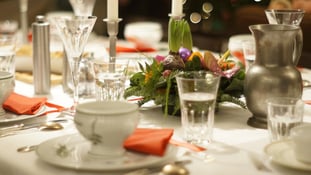I’ve worked with many restaurant owners, and one thing is clear -exceptional service sets fine dining establishments apart. One key technique that top restaurants use is the open-hand service method.
This method ensures servers never reach across guests, maintaining a smooth and respectful dining experience. The rule is simple: use your right arm to serve guests on their right side and your left arm for guests on their left. This prevents awkward contact and keeps service seamless.
By following open-hand service, staff can move gracefully around the table, keeping a respectful distance and avoiding unnecessary disruptions. It’s a small detail, but in fine dining, the details make all the difference.
Key Takeaways
-
The open-hand service method is a server etiquette technique that involves placing items on the dining table without reaching across guests.
-
Open-hand service improves the guest experience, reduces the risk of spills, contributes to faster table turnover, and enhances communication between servers and kitchen staff in fine-dining restaurants.
-
To consistently provide a remarkable guest experience, it is important to combine the principles of open-hand service with other strategies for success, e.g., by leveraging technology solutions like Eat App.
What is the open-hand service method?
The open-hand service method is a standard in fine dining, ensuring smooth and respectful service. Servers use their right arm for guests on their right and their left arm for those on their left, avoiding awkward contact. This approach allows servers to move efficiently around the table while maintaining a respectful distance, ensuring a seamless dining experience.
The open hand method of serving makes it easier to serve guests without accidentally touching them with your arm.
Benefits of the open-hand service method
- Improved guest experience: the open-hand service method helps servers connect better with guests at fine dining establishments. This approach creates a welcoming, attentive atmosphere, making guests feel valued. Adapting to the restaurant industry's changes is essential for providing excellent service and creating memorable dining experiences.
- Reduced risk of spills: fine dining restaurant servers has better stability and control over the dishes and glasses they are serving when they aren’t forced to cross their arms in front of a guest. Getting the angle right and using the appropriate arm when serving eliminates the potential for accidental tipping or collisions, minimizing the chances of spills or breakages.
- Faster table turnover: serving items properly contributes to faster table turnover, which is beneficial for both the restaurant and its guests. In order to implement the open-hand service method, servers need to carry items carefully so that they can lower them onto dining tables smoothly. With this kind of etiquette in place, guests are typically seated, served, and attended to promptly, reducing wait times and accommodating more guests during peak hours.
- Improved communication between servers and kitchen staff: with a clear view of the dining table settings, servers can easily communicate any modifications, special requests, or additional orders to the kitchen. Likewise, kitchen staff can provide necessary updates or information to servers, ensuring accurate and efficient service. This improved communication minimizes errors, avoids delays, and ensures that guests receive their orders precisely as requested.
Pre-service preparation
Pre-service preparation sets the stage for a smooth dining experience. Servers should review the menu, wine list, and daily specials so they can answer questions and make recommendations with confidence. Checking table assignments, guest preferences, and special requests helps ensure personalized service.
The dining area should be ready before guests arrive. Tables must be set properly, linens clean and pressed, and glassware and silverware polished. Lighting should be warm and inviting, and the temperature comfortable.
Servers should also be well-prepared personally; dressed neatly and equipped with the tools they need. These details make all the difference in delivering a professional and memorable dining experience.
The most important server etiquette tips
%20(1)%20(1).webp?width=629&height=944&name=image1%20(4)%20(1)%20(1).webp)
Presenting the menu
When presenting the menu to guests, servers should first introduce themselves, greet the guests, and offer assistance if needed. Servers can then provide recommendations or highlight any specials or promotions available.
In a fine dining establishment, staff should also always make sure to give guests time to review the menu without rushing them.
If the menu has any unique or unfamiliar items, servers can offer explanations or descriptions to help guests decide what to order.
Taking orders
Taking orders requires active listening and clear communication on the server’s part. Servers should give their full attention to guests and be patient while they decide.
As part of fine dining service, staff should be knowledgeable about the menu, able to answer questions, and provide suggestions if requested. They should also inquire about any food allergies or dietary restrictions before explaining menu items to accommodate guests’ needs.
Always repeat the order back to the guests to ensure accuracy.
Serving food
Servers should use the open-hand service method, carrying plates on their open palms and serving from the right for guests on the right and from the left for those on the left.
This prevents awkward movements and maintains a smooth dining experience. Servers should serve one guest at a time, ensuring each is attended to before moving on, while maintaining a pleasant demeanor.
Serving wine
Serving wine should also follow proper etiquette. Servers must serve wine by first presenting the wine bottle to the guest, showing the label, and providing a brief description if requested.
Then, for proper wine service, servers should pour a small amount into the guest’s wine glass for tasting, starting from the guest’s right side. Once the guest approves, the server can proceed to fill the wine glass, again using the right side of the guest.
Restaurant staff should handle the wine bottle gracefully and avoid spilling or dripping on dinner plates.
It is also important to offer assistance if guests need further wine-related services, such as opening a different bottle or providing a wine bucket.
Addressing customers
Addressing customers with respect and professionalism is at the core of formal restaurants’ practice, especially for private dining rooms. Servers should address guests using appropriate titles, such as Sir, Madam, or Mr./Ms. Last Name, unless the guest has indicated otherwise.
Staff should also maintain eye contact, listen actively, and respond promptly to any questions or requests using appropriate restaurant lingo. This demonstrates that they are attentive to guests’ needs throughout the fine dining experience, in addition to offering refills, condiments, or any other assistance.
Clearing the table
Servers should clear tables with good timing, paying attention to guests’ cues. In fine dining, signs that a meal is finished include napkins placed on the table and cutlery positioned vertically on the plate. If a guest leaves temporarily, a napkin on the chair signals they are still dining.
When it’s time, servers should politely ask if guests are finished before clearing plates. Always clear from the right side and avoid reaching across. Be mindful of personal items on the table and never remove them without permission.
Improved table navigation
The open-hand service method isn’t just about serving food, it’s about moving through the dining area smoothly and efficiently. Servers use their right arm for guests on the right and their left for guests on the left, ensuring seamless service without interruptions.
Knowing the table layout and each guest’s position helps servers navigate efficiently while avoiding obstacles. This awareness keeps the dining experience smooth and professional.
In fine dining, proper table navigation is key to great service. Servers trained in this method create a refined, respectful experience that leaves a lasting impression on guests.
Other ways to boost guest experience
There are various other ways to enhance the overall guest experience in your fine dining restaurant. One of them is to utilize the features provided by Eat App, a top-notch hospitality and restaurant management platform designed to streamline venue operations and prioritize customer satisfaction.
Here are some of the main ways that Eat App helps you streamline your restaurant operations and make your customers happy:
- Intelligent booking engine — Eat App offers an intelligent booking engine that enables you to accept reservations 24/7 from various online channels without incurring commission fees. You can directly receive reservations from your own website, as well as platforms like Google and social media.
- Waitlist management — with Eat App, you have complete ownership of guest data, allowing you to track their preferences and effectively manage your waitlist. This feature empowers you to address guests properly, pinpoint their dining preferences, and deliver personalized experiences.
- Pre-payments — this feature enables you to maximize your restaurant’s potential and cater to the unique needs of your guests. Reservation deposits also reduce the occurrence of no-shows, ensuring that your tables are filled and optimizing your restaurant’s revenue.
- Hospitality CRM — Eat App’s centralized CRM allows you to collect and store all guest data in one user-friendly interface. This will help you deliver exceptional service that guests will remember, send targeted marketing campaigns, and keep track of your loyal customers.
Simply put, incorporating Eat App into your fine dining restaurant operations can effectively ensure seamless and personalized customer service. The platform empowers you to optimize your online presence and cultivate strong customer relationships.
-1%20(1).webp?width=629&height=321&name=image7%20(2)-1%20(1).webp)
Conclusion
The open-hand service method is a classic approach to fine dining etiquette, commonly used in traditional restaurants in Japan, Ethiopia, and parts of East Africa. But great service goes beyond this technique, it’s about creating a memorable guest experience.
Restaurant management technology like Eat App helps restaurants track guest preferences, streamline operations, and build stronger customer relationships. Every interaction is a chance to make a positive impression, and improving service and communication leads to long-term success.
Focus on delivering top-notch hospitality, refine your service approach, and use tools like Eat App to keep guests coming back.
FAQs
Do you serve ladies first?
In traditional table service etiquette, it is customary to serve ladies first as a sign of respect. However, modern dining practices have evolved, and it is now more common to serve customers based on their seating arrangement or in the order in which they placed their orders. To ensure inclusivity and avoid assumptions, asking all the guests if they have any specific seating or serving preferences is recommended.
Do you serve food from the left or right?
Food is typically served from the guest’s left side. This means that the server approaches the guest from the left and serves or places the food on the table from that side. This method follows a counterclockwise direction around the table. The open-hand service method, which emphasizes avoiding reaching across guests, also influences the direction in which food is served.
What is the proper way to serve a plate?
When serving a plate for formal dining, it is essential to approach the guest from their right side. With the open-hand service method, servers at a fine dining establishment use their right arm to serve at the guest’s right side. The server positions themselves slightly behind the guest while delivering food, placing the plate gently on the table with their right hand. This technique ensures a smooth and respectful serving motion without reaching across the guest or obstructing their view.
Do you serve drinks from the right or left?
Drinks are traditionally served from the right side of the guest. In the dining room, the server approaches the guest from their right and places the drink on the table from that side. It is important to maintain the same principles of the open-hand service method by using the appropriate arm and avoiding crossing over the guest’s personal space. By serving drinks from the right, servers can provide a seamless and unobtrusive beverage service.














.webp?width=200&name=v2-15mknc-qpw1b%20(1).webp)
.webp?width=200&name=v2-15kqni-p0exl%20(1).webp)
-1.png?width=1812&height=1072&name=TripAdvisor%20%26%20More%20Bookings%20(1)-1.png)
-2.png?width=1812&height=1072&name=Google%20Bookings%20(1)-2.png)


-1.png?width=200&name=TripAdvisor%20%26%20More%20Bookings%20(1)-1.png)
-2.png?width=200&name=Google%20Bookings%20(1)-2.png)
-1.png?width=200&name=Instagram%20Bookings%20(1)-1.png)
-1-png.webp?width=200&name=Facebook%20Integration%20Rectangle%20(1)-1-png.webp)







.webp?width=200&name=download%20(1).webp)
%20(1)-2.webp?width=200&name=Eat%20(34)%20(1)-2.webp)
%20(1)-2.webp?width=200&name=Eat%20(18)%20(1)-2.webp)




.webp?width=670&height=440&name=image2%20(5).webp)




.webp?width=144&height=72&name=Eat%20App%20Logo%20(3).webp)